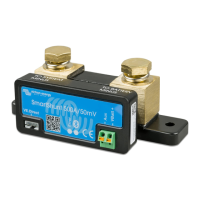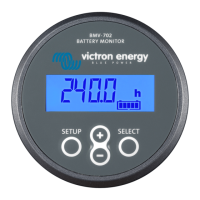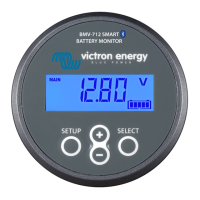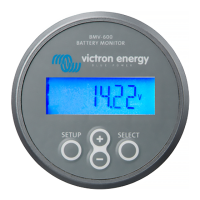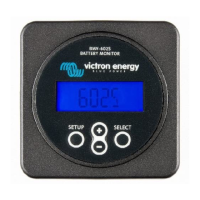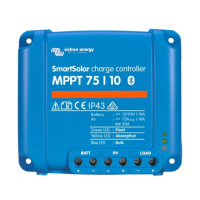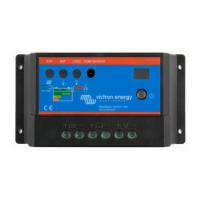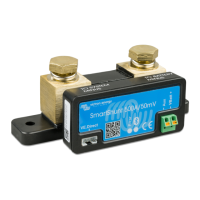
Do you have a question about the Victron energy SmartShunt and is the answer not in the manual?
| Model | SmartShunt |
|---|---|
| Bluetooth | Yes |
| VE.Direct port | Yes |
| Input Voltage Range | 6 - 70 V |
| Current Measurement Range | ±500A, ±1000A, ±2000A |
Warnings related to handling lead-acid batteries and general safety precautions.
Guidelines for safe storage and transportation of the battery monitor.
Explains the function and capabilities of the SmartShunt battery monitor.
Discusses the benefits and importance of monitoring battery health and performance.
Details the different available sizes for the SmartShunt product.
Information on the VictronConnect app and supported platforms for connection.
Lists optional accessories that can be used with the SmartShunt.
Lists the components included in the SmartShunt package.
Instructions and considerations for physically mounting the SmartShunt unit.
Guides on making the fundamental electrical connections for the SmartShunt.
Details on how to connect the battery's negative terminal to the SmartShunt.
Explains the connection of the system's negative terminal.
Instructions for connecting the positive battery voltage (Vbatt+) terminal.
Introduces auxiliary connections for additional monitoring functions.
How to connect the auxiliary port to monitor a second battery's voltage.
Connecting the auxiliary port to monitor battery bank midpoints.
Connects a temperature sensor to monitor battery temperature.
How to connect the SmartShunt to a GX device for monitoring.
Steps to connect and configure the SmartShunt using the VictronConnect app.
Instruction on correctly placing the fuse in the Vbatt+ cable.
Detailed steps for connecting to the SmartShunt via Bluetooth or USB.
Guide for checking and updating the SmartShunt's firmware.
Highlights critical settings that need adjustment for accurate operation.
How to input the correct battery capacity in Amp-hours (Ah).
Setting the voltage threshold to determine a fully charged battery.
Manual setting of the initial State of Charge.
Configuring the role of the auxiliary input (e.g., temperature, starter voltage).
Specific configuration adjustments required for lithium batteries.
Explains the fundamental working principle of the SmartShunt.
Details the parameters displayed on the status screen.
Explains how the SmartShunt synchronizes its state of charge.
Details automatic SoC synchronization methods.
Explains how to manually synchronize the SoC.
Information on how the SmartShunt raises alarms.
Explains the historical data stored by the SmartShunt.
Describes the trend logging feature of the SmartShunt.
Explains the meaning of LED status codes for Bluetooth module.
How to connect the SmartShunt using a USB interface.
Connecting to GX devices and the VRM portal for monitoring.
Connecting to the VE.Smart wireless network for data sharing.
Using VE.Direct for custom data integration and control.
Overview of settings related to battery parameters.
Setting the battery capacity in Amp-hours (Ah).
Setting the voltage threshold to determine a fully charged battery.
Setting the minimum State of Charge before an alarm is triggered.
Setting the tail current threshold for charge detection.
Time required for charge detection to confirm a full charge.
Setting the Peukert exponent for capacity calculation.
Compensates for capacity (Ah) losses during charging.
Threshold to ignore small currents affecting long-term readings.
Averaging period for the time-to-go calculation.
Configures initial SoC state upon power-up.
Manual setting of the current State of Charge.
Manually triggers the State of Charge synchronization.
Calibrates the zero current reading for accuracy.
Configuration options for various alarm triggers.
Sets alarms based on the State of Charge falling below a threshold.
Sets alarms for when battery voltage drops below a specified level.
Sets alarms for when battery voltage rises above a specified level.
Sets alarms for low starter battery voltage when Aux input is active.
Sets alarms for high starter battery voltage when Aux input is active.
Triggers alarms for deviations in battery bank midpoint voltage.
Sets alarms for when battery temperature exceeds a limit.
Sets alarms for when battery temperature drops below a limit.
Covers various other configuration options.
Configures the function of the auxiliary input port.
Adjusts capacity based on battery temperature coefficient.
Selects Celsius or Fahrenheit for temperature display.
Settings related to the product itself.
Resets all device settings to their factory default values.
Assigns a custom name to the SmartShunt for identification.
Information and guidance on updating the device firmware.
Instructions on how to change the Bluetooth PIN code.
Procedures for managing Bluetooth connectivity.
Location of the device's serial number for reference.
Features for managing, saving, and sharing configuration settings.
Option to clear the device's historical data.
Procedure to reset the Bluetooth PIN code to its default.
Explains battery capacity rating and the Peukert exponent.
Demonstrates calculating capacity using 5h and 20h ratings.
Wiring diagrams for connecting and monitoring battery bank midpoints.
How to connect for midpoint monitoring in 24V battery banks.
How to connect for midpoint monitoring in 48V battery banks.
Calculates the midpoint deviation in percentage.
Setting the threshold for midpoint deviation alarms.
Setting the delay before triggering a midpoint deviation alarm.
Actions to take when a midpoint deviation alarm occurs during charging.
Actions to take when a midpoint deviation alarm occurs during discharging.
Information about the Battery Balancer accessory for equalizing charge.
Troubleshooting common functional problems with the SmartShunt.
Diagnosing a unit that shows no signs of power or activity.
Troubleshooting issues with the auxiliary port.
Troubleshooting problems encountered when trying to change settings.
Troubleshooting common connectivity problems.
Resolving issues preventing a Bluetooth connection.
Steps to recover or reset a lost Bluetooth PIN code.
Troubleshooting inaccurate measurements from the SmartShunt.
Correcting when charge and discharge current readings are swapped.
Diagnosing issues causing incomplete current readings.
Resolving false current readings when no actual current is flowing.
Troubleshooting inaccurate State of Charge readings.
Resolving when the State of Charge reading is absent.
Diagnosing why the State of Charge does not reach full charge.
Fixing issues where the State of Charge remains fixed at 100%.
Adjusting settings for incorrect State of Charge speed during charging.
Troubleshooting inaccurate battery voltage readings.
Diagnosing errors with the starter battery voltage readings.
Resolving problems with automatic State of Charge synchronization.
